So after this brief introduction about PV technology and application, it is about time to dig deeper into the components that form this PV system and learn more about the types of systems that can serve various applications.
We can easily observe that not all PV systems are alike in terms of system components, size, and type of application. For example, solar water pumping for rural application, where there is no access to an electricity grid, utilizes components that are slightly different from rooftop solar systems for residential application, where a grid already exists.
So what are these main types and components that form the PV system?
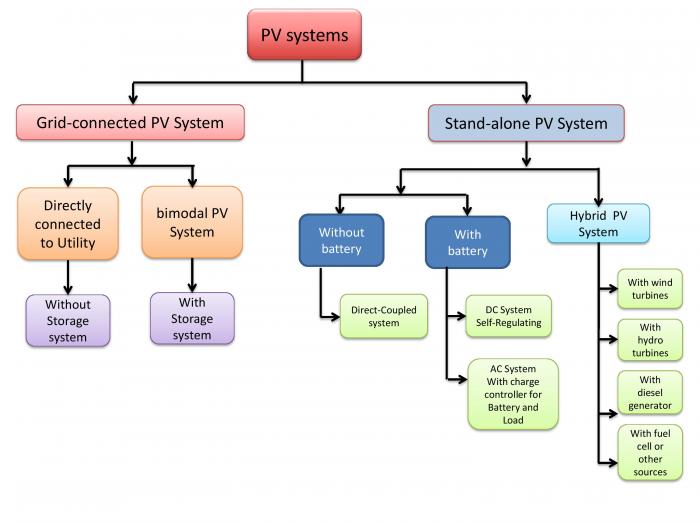
PV System Types and Their Components
PV systems can be divided into two categories: Grid-connected PV Systems and Stand-alone PV Systems.
Grid-connected PV Systems can further be separated into two categories: those that are Directly Connected to the utility and those that are classified as Bimodal PV Systems.
Systems that are Directly Connected to the Utility are without a storage system, and systems that are classified as Bimodal PV Sytems do have storage systems.
Stand-alone PV Systems can be divided into three categories: Without Battery, With Battery, and Hybrid PV Systems.
Without Battery systems are Direct-Coupled systems, and With Battery systems may include Self-Regulating DC Systems or AC Systems with a charge controller for the battery and load.
Hybrid PV Systems may include systems with wind turbines, with hydro turbines, with diesel generators, or with fuel cells or other sources.
In Figure1. 7 we can see different types of PV configurations that work for both Grid-connected and Stand-alone applications. We can see that the main difference between these two main types is utility grid availability.
Stand-alone PV systems:
All stand-alone (AKA off-grid) systems work in general without the utility grid, as shown in Figure 1.8. It can be seen that we expect a perfect match between the supply and demand, or in other words between PV system size and load requirement. When this match is done perfectly for a single load, the PV system in this case can be called a "Direct-Coupled PV System," and very minimal components are needed without the need for storage systems.
Another type of stand-alone requires a storage system to allow excess energy to be stored when it is not needed by the load and can later be drawn when the sun is not available. This type can be connected directly to DC loads or to AC loads through an additional power conditioning component, or “Inverter,” as we will learn later.
The other common type of stand-alone system is the "Hybrid PV System," as illustrated in Figure 1.9, which uses other energy sources in parallel to the PV array to supply loads. These energy sources can be Wind Turbines, Hydro Turbines, Diesel Generators, or Fuel cells. Hybrid PV Systems can also use Batteries for energy storage.
Grid-Connected system:
This type of configuration is the most common type for applications where clients want to save energy on their utility bills and while the utility grid exists for use when the PV array is not generating any energy. The PV array can be directly coupled to the grid without any storage system and is called “Utility-Interactive PV System or Grid-Tied PV System,” as illustrated in Figure 1.10. Alternatively, it can store excess energy into battery banks for later use, and in this case, it is called a “Bimodal PV System or Battery Backup PV System,” as shown in Figure 1.11.
The following short video walks us through the basics of PV and how it works and shows an example of a grid-connected PV system and the components needed.
Video: How Solar Works (0:58)
As shown in the video, a solar array can be installed on a rooftop for residential application. After all mechanical holding structures are installed on the roof, the solar panels can be fastened to it . When the sun shines on PV panels, photons are converted into electrons that form electrical current when it moves towards the circuit terminals . The electrical DC current then travels through conduits down towards a power conditioning unit (AKA inverter) . The current is converted to AC electrical current and travels through an AC disconnect box . When the AC current exits the disconnect box, it goes through a PV production meter to count energy generated . After that, the current is backfed to the lower side of the Main distribution panel (MDP), where all load circuits are connected, through a protection breakers . When the PV array is generating power, the load circuits draw power from the PV array instead of the grid . While the PV array is generating power, the monitoring device is transmitting the data to an online portfolio, where clients can see their instantaneous PV array performance online . Finally, the excess energy generated from the PV array is returned to the utility grid .
Another example of a 100 percent off-grid system installed on an isolated island is illustrated in the following video.
Video: How Tokelau Switched to Solar Energy (4:21)
PRESENTER: Two billion people on Earth still don't have access to electrical power, like the 1,500 inhabitants of Tokelau, three lonely atolls in the middle of the Pacific, the largest ocean on Earth. You couldn't be further away from a power grid. 500 islanders live on each atoll, not more than a small village.
Until two years ago, diesel generators provided the island with power for household appliances. 2,000 oil drums per year had to be shipped 500 kilometers from Samoa and manhandled from the freighter onto the island, cost per year about $1 million. That is until the Tokelauans found the most obvious solution, the sun, the most powerful energy source available on our planet.
It releases more energy per second than all nuclear power plants worldwide could produce in 750,000 years. And if you are close the equator, like Tokelau, the sun gives away its energy even more generously. That's why, with the help of technicians from New Zealand, the Tokelauans pulled up their sleeves, and installed three solar power plants, one on each atoll with a combined output of one megawatt, enough to switch off the diesel generators and make a better use of the empty oil containers as drums for the dance.
Over 4,000 solar panels have been installed, hundreds of battery inverters that convert the solar current into alternating current. They are the core of the installation and guarantee a secure, reliable, and independent power supply. Over 1,300 batteries with 8,000 kilowatt capacity store the surplus. Thereby, Tokelau has not only the largest off grid power plant in the world, Tokelauans can also be proud to be the first nation on Earth to go what 100% solar, setting an example for the world.
A technician from New Zealand controls the plant from a laptop.
SHANE ROBINSON: We have the ability to completely control this computer from overseas. So if there is ever our fault or a problem that they have a question on, we can dial into the computer and help diagnose the problem.
PRESENTER: The old generators still serve as backup, but nobody wants to go back to using them again.
ROBIN PENE: I remember when I first came here in 1987. There was only about six hours power a day if you were fortunate. So since the 11,000 volt energy has been provided, they've sort of become quite accustomed to the use of energy.
PRESENTER: Of course, kids watch smaller TV now, but 24 hours of power a day also means that the internet is always on, and Tokelauans are not as isolated from the world anymore. For example, this young girl is able to take on an online language course at a New Zealand university without having to travel the 36 hours by ferry and another three hours by plane.
And at last, Tokelauans can afford to have fridges and freezers. The days of fresh catch of fish rots away because of a power outage are long gone. With its switch to solar, Tokelau now holds the number one spot worldwide by having achieved the greatest reduction in fossil fuel use in percent, largest reduction in carbon emissions per person, using more renewable energy than any other country or place.
SHANE ROBINSON: It's great to see a community like this reducing their reliance on fossil fuels, and the amount of time it frees up. They used to have to have someone sitting here maintaining and watching diesel generators all the time, and now they're out fishing.
PRESENTER: More and more islands in the Pacific want to follow Tokelauans by switching to solar energy. Little Tokelau has shown them the way.
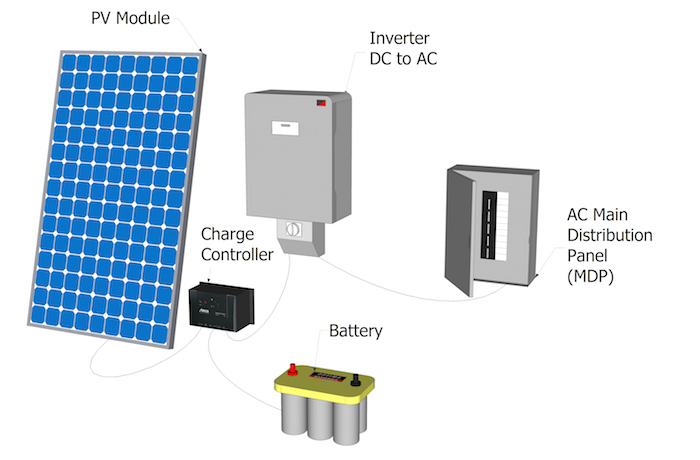
Diagram of a "stand alone AC PV System." It shows the parts of the system and how the energy flows from one to the other. The flow of energy is represented in a list below:
- PV Module
- Charge Controller
- Battery and Inverter DC to AC
- AC Main Distribution Panel (MDP)
- Battery and Inverter DC to AC
- Charge Controller
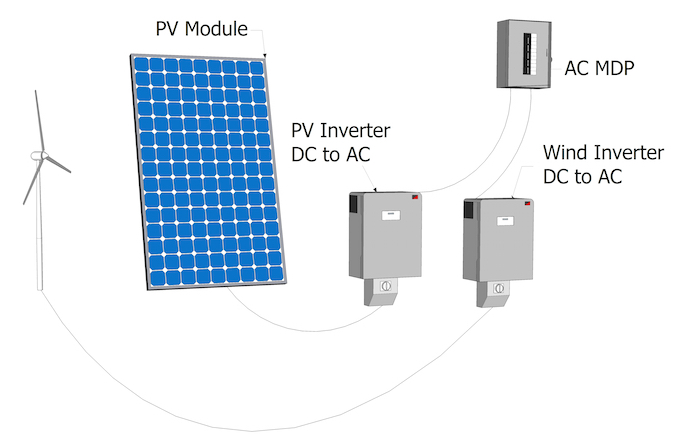
Diagram of a "Hybrid PV System." It shows the parts of the system and how the energy flows from one to the other. The flow of energy is represented in a list below:
- PV Module or wind
- PV Inverter DC to AC and wind Inverter DC to AC
- AC Main Distribution Panel (MDP)
- PV Inverter DC to AC and wind Inverter DC to AC
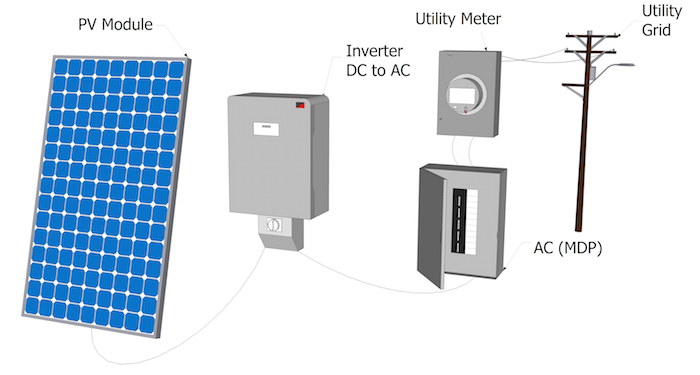
Diagram of a "Utility Interactive PV System." It shows the parts of the system and how the energy flows from one to the other. The flow of energy is represented in a list below:
- PV Module
- Inverter DC to AC
- AC Main Distribution Panel (MDP)
- Utility Meter
- Utility Grid
- Utility Meter
- AC Main Distribution Panel (MDP)
- Inverter DC to AC
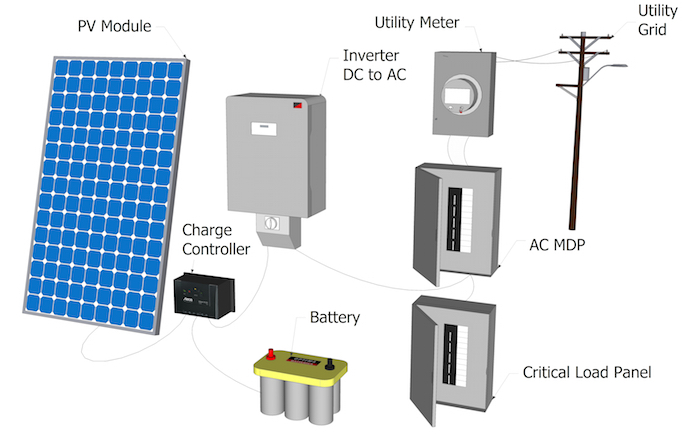
Diagram of a "Bimodal PV System." It shows the parts of the system and how the energy flows from one to the other. The flow of energy is represented in a list below:
- PV Module
- Charge Controller
- Battery and Inverter DC to AC
- AC Main Distribution Panel (MDP)
- Critical Load Panel and Utility Meter
- Utility Grid
- Critical Load Panel and Utility Meter
- AC Main Distribution Panel (MDP)
- Battery and Inverter DC to AC
- Charge Controller
In order for each of the PV system types we discussed in this section to function and deliver usable energy to clients, a number of components are needed to allow energy to be generated, conditioned, stored, and transferred to end users. So what are these components, according to the classification: generation, storage, and conditioning?
Generation:
The main and only component in the PV system that converts solar radiation into electricity is the "Cell" or "Module." We will learn more about that in Lesson 2.
Storage:
Not all energy the PV system generates is used right away, especially when we talk about off-grid systems. So in order for us to maximize the usage of the system, we need some devices to store the energy for later uses, and that is easily done using "Storage devices such as Batteries." We will explain more in Lesson 3.
Conditioning:
Solar PV generates DC electricity, which is not the common form to be used for home appliances and the utility grid in general, which usually uses AC electricity. So in order for us to be able to connect the PV system to the grid we need to change the DC to AC, and that is done using a power conditioning units AKA "inverter." We will discuss this in more detail in Lesson 4.
Review:
General PV system components are extensively discussed in previous classes. You can refer to "EME 812 (Lesson 6.2. Main components of the PV systems)" to review or learn about main components used for PV systems and their functions. (Note: link is also located on the Review page of this Lesson.)